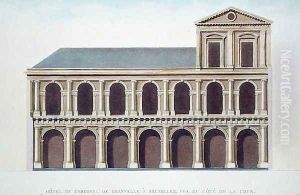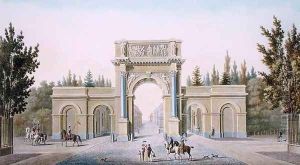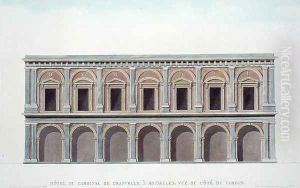Suys, Tilman-Francois Paintings
Tilman-François Suys, also spelled as Tilman-François Suÿs, was a Belgian architect who played a significant role in the development of neoclassical architecture in Belgium and the Netherlands during the late 18th and early 19th centuries. He was born on August 1, 1744, in Oudenaarde, Belgium, into a family with artistic interests; his father was a sculptor. Suys initially showed a talent for drawing, which led him to pursue a career in architecture.
Suys embarked on his architectural studies in his native Belgium before moving to Paris to further his education. In Paris, he had the opportunity to study under renowned architects such as Charles De Wailly and Richard Mique, who were at the forefront of the neoclassical movement. The neoclassical style sought to revive the principles and aesthetics of classical antiquity and was characterized by its simplicity, symmetry, and use of classical orders.
During the turbulent times of the French Revolution, Suys left Paris and returned to Belgium. It was there that he began to make his mark, contributing to the urban planning and architectural character of cities such as Brussels and Amsterdam. He became the court architect to Louis Bonaparte, who was made King of Holland by his brother, Emperor Napoleon Bonaparte. Suys designed several important buildings in Amsterdam, including the Mint Tower and the Mozes en Aäronkerk.
Perhaps one of Suys' most notable works is the Laeken Cemetery in Brussels, which he designed in the style of an English garden. His design included landscaping that highlighted the solemnity and beauty of the place, making it a notable example of cemetery architecture of the period.
In addition to public and religious buildings, Suys also made contributions to residential architecture. He designed a number of private homes in the neoclassical style, which were characterized by their balanced proportions and reference to classical elements.
Suys' impact on architecture extended beyond his own projects. He was a professor of architecture at the Academy of Fine Arts in Amsterdam, where he influenced the next generation of architects. His teachings and designs helped to propagate the neoclassical style, which remained popular well into the 19th century.
Tilman-François Suys passed away on July 22, 1826, in Brussels. His legacy is preserved in the buildings he designed and in the influence he had on the architectural language of his time. His works remain as enduring examples of neoclassical architecture, reflecting the cultural and aesthetic ideals of his era.


